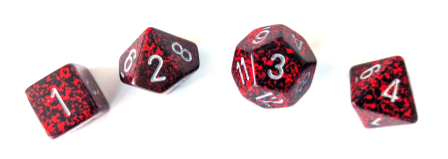Google Code Jam '22 Qualification Round Problem C - d1000000
View as PDFWhile the most typical type of dice have sides, each of which shows a different integer
through
, there are many games that use other types. In particular, a
is a die with
sides, each of which shows a different integer
through
. A
is a typical die, a
has four sides, and a
has one million sides.

In this problem, we start with a collection of dice. The
die is a
, that is, it has
sides showing integers
through
. A straight of length
starting at
is the list of integers
. We want to choose some of the dice (possibly all) and pick one number from each to form a straight. What is the longest straight we can form in this way?
Input Specification
The first line of the input gives the number of test cases, .
test cases follow. Each test case is described in two lines. The first line of a test case contains a single integer
, the number of dice in the game. The second line contains
integers
, each representing the number of sides of a different die.
Output Specification
For each test case, output one line containing Case #x: y, where is the test case number (starting from
) and
is the maximum number of input dice that can be put in a straight.
Limits
Test Set 1
Time Limit: 5 seconds
Test Set 2
Time Limit: 15 seconds
Sample Input
4
4
6 10 12 8
6
5 4 5 4 4 4
10
10 10 7 6 7 4 4 5 7 4
1
10Sample Output
Case #1: 4
Case #2: 5
Case #3: 9
Case #4: 1Explanation for Sample
In Sample Case #1, there are multiple ways to form a straight using all dice. One possible way is shown in the image above.
In Sample Case #2, since none of the dice can show an integer greater than , there is no way to have a straight with more than
dice. There are multiple ways to form a straight with exactly
dice. For example, pick the integers
and
for both
's and then integers
,
, and
for three of the
's to form
.
In Sample Case #3, it is possible to form the straight by discarding one
and using the
's,
, and
to get
through
; the
's to get
through
; and the
's to get
and
. There is no way to form a straight of length
, so this is the best that can be done.
In Sample Case #4, we can only form a straight of length , but we can do so by picking any integer for the
we are given.
Note
This problem has different time limits for different batches. If you exceed the Time Limit for any batch, the judge will incorrectly display >15.000s regardless of the actual time taken. Refer to the Limits section for batch-specific time limits.
Comments